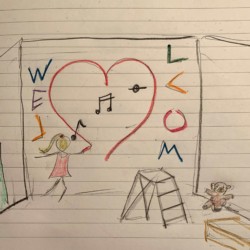I recently befriended a beguiling six-year-old named Susie Simpson.
My all-grown-up friend, Susan Lennox (nee Simpson), introduced us. Susie lives in a tucked away drawer in Susan’s chest of memories.
Susie Simpson used to love to sing Christmas carols in July, wear tights with rainbow stripes and hopscotch her way across the street. But since her family moved house last year, she’s become quieter and more subdued.
Sometimes, grown-up Susan feels the urge to put on a sequined bowler hat and sing along to oldies while she sets the table, using a salt shaker as a mike.
When she does, Susie busts out of her memory drawer, yanks the salt shaker away and admonishes Susan to, “CUT THAT SILLINESS OUT NOW!!”
Susie knows that being playful brings trouble.
She learned her lesson on moving day. As her parents packed away the silverware, Susie crayoned a welcome mural onto her bare bedroom wall. The microcosm of rainbows, poppies and ducklings in thirty-seven different shades of Crayola lit Susie right up. Imagining the delight of the newcomers eased her sense of foreboding about moving to a bare, empty new house herself . . .
. . . Until her mother walked in, unleashed a cry of strangled fury, and proceeded to scrub the mural off the wall in white knuckled silence.
The silence continued for hours. It was more scary than the scream.
It was the first of many silences that year. With each silence, Susie grew more certain that if something feels fun, generous and wacky, it’s safer to change course and circle back to the serious, restrained and predictable. Eventually, the thought of fun — and especially, the yearning for it — made Susie feel sick to her stomach.
At the time Susie-Susan-Simpson-Lennox told me her story about the mural, I was harbouring an extended case of writer’s block. (Or perhaps, it was harbouring me).
By the time she finished, I was done with writer’s block.
I wanted a different possibility for Susie — because I wanted to set Susan free to karaoke in her kitchen again.
So I wrote a picture book manuscript in which Mum scrubs away the mural — but doesn’t find the pet cat Susie drew behind the cupboard closet. The girl who moves in discovers it. Years later, the pair meet as university roommates, and christen their room by drawing a mural of cats with linked tails.
I wrote quickly, with an eager sense of purpose. I did not have an address for Susie Simpson, so I sent my story to Susan Lennox, with best love.
Susan and Susie read my story together, cuddled up on the living room couch.
Susie handed Susan a tissue. Susan mussed Susie’s hair. Susie tossed Susan a sparkly bowler hat, and told her to crank up Forever Young on the stereo. They sang into salt-and-pepper shaker mikes while they set the table for family dinner.
And because Susan was feeling a bit giddy, she affixed felt stick-on moustaches to everyone’s water glasses. Susie added googly eyes. Husband and sons were much amused.
While writing is an intensely solitary pursuit, it has facilitated some of the most meaningful human connections I’ve ever experienced. This paradox keeps me writing, because it offers me a way through my own paradox, as an introvert with a keen desire to befriend, defend, and facilitate life change.
I am particularly aware of the power of this paradox when loved ones are kind enough to share their memories — and generous enough to lend them to me as story material.
We use stories to make sense of our pain, and also to heal it, by offering a space for empathy, appreciation, re-discovery and renewal.
And sometimes, it’s possible to set a tiny corner of the world right through the rite of write.
***
How has story-sharing shaped your relationships and your writing?



No comments yet.